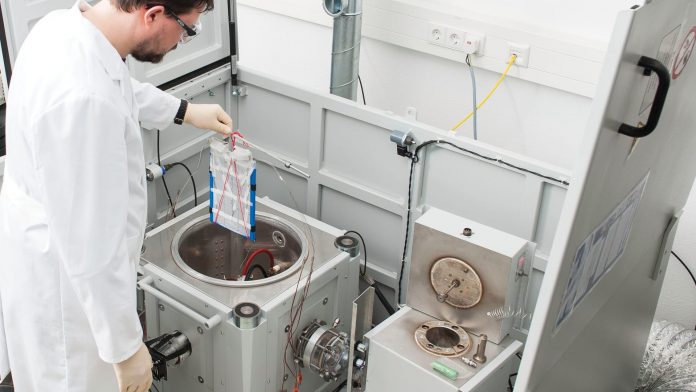Dr Carlos Ziebert, head of the Calorimeter Centre at Karlsruhe Institute of Technology’s Institute of Applied Materials – Applied Materials Physics, outlines how research and testing in battery calorimetry is crucial to safety development.
Established in 2011, the Calorimeter Centre at the Karlsruhe Institute of Technology’s (KIT) Institute for Applied Materials – Applied Materials Physics (IAM-AMP), now operates Europe’s largest battery calorimetry laboratory. It provides six Accelerating Rate Calorimeters (ARCs) of different sizes – from coin to large pouch or prismatic automotive format, which allow the evaluation of thermodynamic, thermal and safety data for Lithium-ion and post-Lithium batteries on material, cell and pack level for both normal and abuse conditions (thermal, electrical, mechanical). With these facilities, and the established expertise, the IAM-AWP is now seen worldwide as one of the few institutions that investigates both the thermodynamics and the safety of batteries and their materials. It is clear that safety issues have a major influence on consumers’ willingness to adopt battery systems.
Safety first
Safety comes first– this is the mission of the battery calorimetry centre’s head, Dr Carlos Ziebert. The development of safe cells is of great importance for a breakthrough of the electrification of transport and for stationary storage, because an uncontrollable increase in temperature of the entire system – so-called thermal runaway – can cause an ignition, or even explosion, of the battery with simultaneous release of toxic gases. Thermal runaway is, of course, something that nobody wants, especially in an electric car or another electric vehicle; the causes and effects of this can be very diverse and complex (see Fig. 1). Either internal or external mechanical operating or thermal stresses lead to an internal heating of the cell that initiates different exothermal reactions, followed by a further temperature and pressure increase. The final effects can be empirically classified by the Hazard Level (1-7).
Cell designs, component integrity, manufacturing and ageing processes all have critical influence on the safety of Li-ion batteries. To avoid thermal runaway, the system must be designed optimally on material, cell, pack and system level for the technical and commercial requirements. As such, it is crucial to conduct thermodynamic studies of the thermal effects together with the material and cell development for advanced and even post-Lithium systems. Thus, the complete scientific and technical understanding of these effects is of utmost importance.
Benefits of battery calorimetry
Calorimetry – or the process of measuring heat data during chemical reactions – allows the collection of quantitative data required for optimum battery performance and safety. Sophisticated battery calorimetry, combined with thermography, allows new and quantitative correlations to be found between different critical safety and thermally related parameters. This is very important as you need to know how many Watts a cell will produce under every condition, in order to adapt the battery and thermal management systems. The temperature, heat and internal pressure evolution can be studied, while operating cells under conditions of normal use, abuse or accidents. Such abuse tests without the benefit of battery calorimetry have two main disadvantages:
- The maximum safe temperature would be underestimated (i.e. the cell would be perceived to be less hazardous); and
- The thermal runaway consequences would be understated in terms of severity and speed.
Moreover, a battery calorimetry test is much more sensitive than a hotbox test and reveals the entire process of the thermal runaway with the different stages of exothermic reactions. This data is essential for battery management, thermal management and safety system design. Combined with multiscale electrochemical-thermal modelling they provide a powerful tool for thermal runaway prevention and ageing prediction.
Safety testing in battery calorimetry
A 40 Ah pouch cell is inserted into the calorimeter chamber, which has heaters and thermocouples located in lid, bottom and side wall. These adjust the required ambient conditions. The battery calorimeters provide thermal stability data on materials level, e.g. of anodes, cathodes or electrolytes or their combinations and to perform safety tests on cell and pack level by applying:
- Electrical abuse: external/internal short circuit test, overcharge test, over-discharge test.
- Mechanical abuse: nail penetration test.
- Thermal abuse: Heat-Wait-Seek test, ramp heating test, thermal propagation test.
As a result of the different battery calorimetry tests, quantitative and system relevant data for temperature, heat and pressure development of materials and cells are provided. This data can be used on all levels of the value chain, from safe design at materials level, up to thermal management and adaption of safety systems, or implementation into modelling and simulation tools.
Currently, the thermal propagation testing is becoming a very hot topic, because a standardised procedure is needed to develop and qualify suitable countermeasures, such as heat protection barriers. Thus, a global technical regulation on electric vehicle safety is being developed by all relevant stakeholders. In the near future, battery calorimetry will be also needed to assess the thermal and safety properties of advanced materials such as solid state batteries or other systems, which could replace Lithium such as sodium or magnesium.
This must be started on a smaller scale level and has to be continued to ensure that the cells can be up-scaled and remain safe. There are still challenges that have to be overcome and we hope that our Calorimeter Centre in close co-operation with our partners in the European Energy Research Alliance Joint Programme on Energy Storage will help the European Industry to make further progress in the field of battery calorimetry, which is urgently needed to reach a low-carbon future, to foster European leadership and to create new jobs as it should be achieved by the European Battery Alliance.
Dr. Carlos Ziebert
Head of the Calorimeter Centre
Karlsruhe Institute of Technology
Institute of Applied Materials – Applied Materials Physics
+49 721 608 22919
carlos.ziebert@kit.edu







